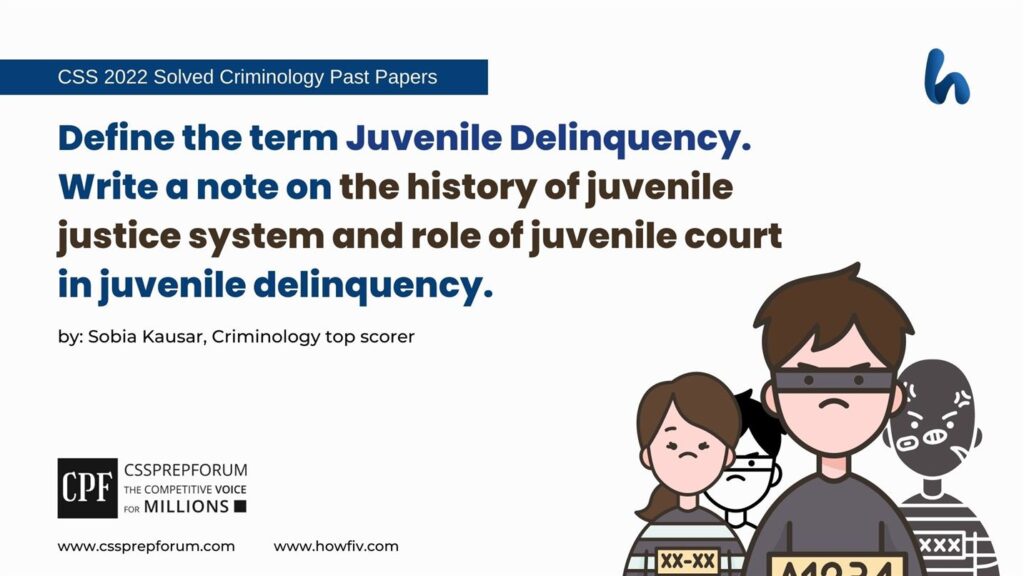CSS Solved Criminology Past Paper 2022 | Define the term Juvenile Delinquency. Write a note on the history of the juvenile justice system and the role of the juvenile court in juvenile delinquency.
The following question is attempted by Sobia Kausar, the top scorer in the CSS Criminology paper. Moreover, the answer is written on the same pattern, taught by Sir to his students, scoring the highest marks in compulsory subjects for years. This solved past paper question is uploaded to help aspirants understand how to crack a topic or question, how to write relevantly, what coherence is, and how to include and connect ideas, opinions, and suggestions to score the maximum.

Question Breakdown:
In this question, the examiner has asked three things to explain. Firstly, what is juvenile delinquency? Secondly, as the world is facing multiple social problems nowadays and juvenile delinquency in one of them. So, examiners want to know the history of the juvenile justice system, like the motive behind the establishment of the juvenile justice system, and when and where it was first established. Thirdly, the most important part of this question is the role of the juvenile court in the juvenile justice system Moreover, if you want to fetch a good score in criminology, then it is pertinent to apply relevant theories so that your question gets maximum weightage and fetch you good marks. Furthermore, I have written a comprehensive and brief outline and solved the question to help you break such questions down, deal with them, and attempt them on paper. If you read it carefully, you will know how I scored the highest marks on the paper.
Outline:
1- Introduction
2- Who is the Juvenile?
3- Definition of juvenile delinquency
- ✓ Legal definition
- ✓ Behavioural definition
4- Historical Perspective of the Juvenile Justice System
- ✓ Code of Hammurabi
- ✓ Codification of Roman Law
- ✓ Chancery courts created by the king of England.
- ✓ Separation of juvenile and adult offenders in the United States of America
- ✓ House of Refuge (institutional custodians acted as parental substitutes)
5- Prevention of delinquency
- ✓ UN convention on the rights of the child (CRC) 1989
- ✓ UN Standard Minimum Rules for the administration of juvenile justice: The Beijing rules 1985
- ✓ The Havana Rules 1990
6- Role of juvenile court
- ✓ Separate Trial of juveniles
- ✓ NO death penalty
- ✓ Absence of irrelevant person during court proceedings
- ✓ Rehabilitation programs
- ✓ Law encourages probation instead of prison.
- ✓ No publications of court proceedings
7- Conclusion

Answer to the question
Introduction:
In any society where there is an abundance of social and moral inequalities, youth is likely to fall prey to criminal activities. A person who does not reach the legal age and commits an offence is known as a juvenile delinquent. Youth is usually the main factor which always plays a constructive role in the making of a prosperous society. But if the youth has started doing an immoral activity, it is considered an alarming situation. To rectify this situation, various efforts have been seen by the world in the form of the evolution of the juvenile justice system. The juvenile justice system has a long and evolving history, dating back to the late 19th century. In the late 1800s and early 1900s, the concept of “juvenile delinquency” emerged, and states began to establish juvenile courts as separate entities from adult criminal courts. The primary focus of these courts was on rehabilitation and reform, rather than punishment. In the 1960s and 1970s, a shift occurred towards a more punitive approach, with laws being passed that allowed for more severe penalties for juvenile offences and the transfer of certain juveniles to adult criminal court. However, in the 1990s and 2000s, there was a move back towards a more rehabilitative approach, with a greater emphasis on evidence-based programs and alternatives to detention. Despite these shifts, the juvenile justice system continues to be the subject of ongoing debate and reform efforts.
Who is a juvenile?
A juvenile is a person who has not attained a legal age that is less than 18 years. However, legal age varies from country to country. For example, in Pakistan, the legal age is 18 years.
Juvenile Delinquency:
- Legal Definition:
Violation of the law is committed by a juvenile that would have been a crime if committed by an adult. For example: theft, stealing, sexual activities.
- Behavioural Definition:
Conduct of a juvenile characterized by antisocial behaviour, such as absenteeism, lethargy, ill-mannered behaviour, and running away from home.
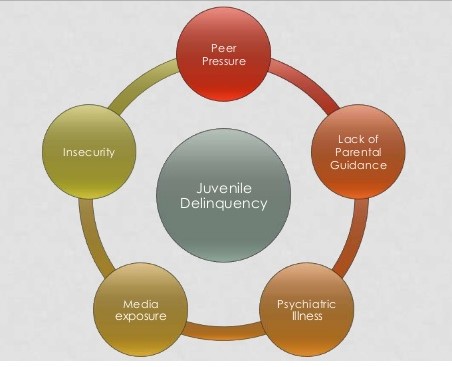
History of Juvenile Justice System:
The juvenile justice system has not evolved overnight. However, it takes plenty of time to evolve in the present-day justice system. The evolutionary history of the juvenile justice system is as follows:
- Code of Hammurabi:
It was the first major code of laws established about 1725 B.C. by the Babylonian King Hammurabi. It established offences and set punishments. The principle of the Code was that ‘’the strong shall not injure the weak’’. No capital punishment was to be imposed on those offenders less than twenty years of age.
- Codification of Roman Law:
The codification of Roman law made it clear that children were criminally responsible for the violation of laws and must be dealt with by the criminal justice system. However, punishment for some offences was less severe for children than adults. For example, the adults caught in the theft were subject to flogging and enslavement to victims, but children only received corporal punishments at the discretion of the magistrate and were required to restitution.
- Chancery courts created by the king of England:
Another important development occurred in the juvenile justice system during the 15th century when chancery courts were created by the king. These courts had a major aim at considering petitions of those people who need help from the state, like children, women etc. In other words, through the chancery courts, the king assumed the rights of parens patriea ( parents of the country) by enabling these courts to act in loco parentis (in place of parents). In short, the king assumed the responsibility to provide parental support to homeless children and to give them institutional support so that they do not commit any sort of offence later in their life.
- Separation of juvenile and adult offenders in the United States of America:
As early as 1825, an important initiative had occurred in the juvenile justice system. The Society for the Prevention of Juvenile Delinquency advocated separating juveniles and adult offenders. Up to this point, youthful offenders generally had been subjected to the same prisons and penalties as adults, with little or no attempt being made to separate juveniles from adults in jails and prisons This step caused a great deal of interest for reformers who feared that criminal techniques and attitudes would be passed from the adults to juveniles.
- House of Refuge (institutional custodians acted as parental substitutes):
House of refuge was a charitable step to provide safety and shelter to destitute youth. This initiative was highly appreciated worldwide and became paramount in establishing a better juvenile justice system.
Prevention of delinquency:
In order to strengthen the juvenile justice system and for the prevention of delinquency, several laws have been enacted worldwide. Some of them are given below.
- UN Convention on the Rights of the Child (CRC) 1989:
Article# 37: States childs’ rights to protection from torture, degrading treatment, punishment, life imprisonment, and unlawful deprivation of liberty.
Article# 39: Right to receive rehabilitation and reintegration.
Article# 40: deals with juvenile justice. It involves treatment from the time of allegation is made through investigation, arrest, charge, trial and sentence.
- The Riyadh Guidelines (1985):
It concerns all levels and forms of juvenile justice. It involves the creation of social justice and social integration of child offenders.
- UN Standard Minimum Rules for the administration of juvenile justice: The Beijing rules 1985
It strictly prohibits capital punishment.
- The Havana Rules (1990):
It deals with Fundamental rights of the children like liberty, education etc.
Role of juvenile court:
Any functional system is considered successful only if it is playing its role holistically. The role of every established system is pre-defined. Likewise, some of the assigned roles of the juvenile justice system are as follows.
- Separate Trial of juveniles:
Juvenile justice system procedure differs from adult offenders. Each state deals specifically with juvenile offenders. Juvenile offenders came into police contact either being directly caught for committing crimes or referred by parents or school officials. Police deal with this either by issuing a warning or detaining minors and informing parents. After doing this, police refer the case to the juvenile court, where the probation officer either dismisses a case or files formal charges according to the nature of the offence, the age of the offender, the offender’s previous criminal record and his educational and social history. In Pakistan, Section 5 of the Juvenile Justice System Act 2018 deals with the arrest and separate trial of the juvenile offender.
- No death penalty:
Around the globe, offenders under the age of 18 are exempt from the death penalty. International Human Rights law has strongly prohibited the concept of awarding the death penalty to juveniles. The main notion behind this verdict is that the age at which the juvenile commits the crime is not a legal age and critical areas of the brain relating to judgment, thrill-seeking, and consequential thinking do not mature until the mid-twenties. According to Reformative theory, the age at which a juvenile has executed bad behaviour under conditions which may never happen again. Hence an effort should be made to transform him during the hour of his confinement. In Pakistan, Section 16 of the juvenile justice system act 2018 prohibits the death penalty, handcuffing, imprisonment, order to labour, put to fetter, and corporal punishment.
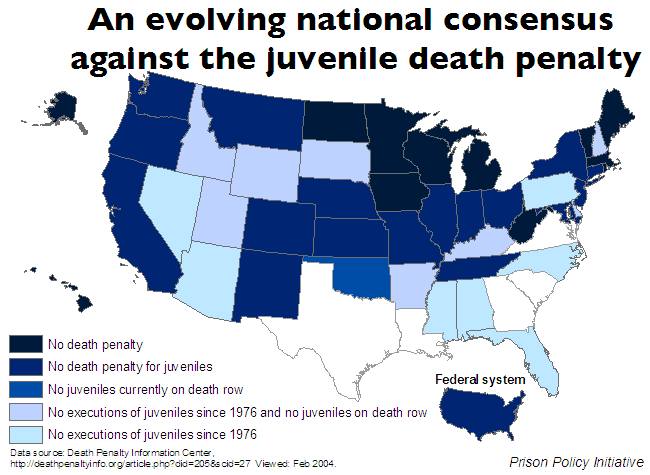
- Absence of irrelevant person during court proceedings:
Court proceedings of the juvenile are very confidential. Only his/her parents are allowed to attend the court proceedings. The main motive behind this initiative is to refrain juveniles from any kind of social stigma after getting bail or being released from jail or an offence. Punishment is something that should be inflicted very carefully. As the famous saying goes that ‘’Let go of a hundred guilty, rather punish innocent.’’ It has a very grave impact on his mental, physical, and social status drastically. If while administering the criminal justice system, utter carefulness has to be executed, or else the very principles of the justice world o for a toss.
- Rehabilitation programs:
Youth is considered the currency of any country. If the youth gets involved in such illegal activities, then it is a very alarming situation for the prosperity of that country. Special programs to prevent substance abuse, improve mental health, and continue education was framed for sexual offenders, women parolees, and children in conflict with the law. The importance slowly downgraded as the twentieth century progressed towards its end. It regained momentum as human rights concerns are high on the activists’ list. These are transitional homes where the child is kept before totally reintegrating into society. Aftercare organizations are special homes registered under the governmental nodal agency functions for the welfare of delinquent children.
At the aftercare organizations, the Juveniles were given,
- Vocational training
- Therapeutic training to improve psychological behaviour.
- Continuing education
- Consensus about social values
- Economical ability to support themselves.
- Activities for physical and mental fitness
The juveniles are taken care of in the After Care Organisation, which is a transitional home after they leave the special homes and children’s homes. Juveniles in conflict with the law and children in need of care and protection, both categories are placed in aftercare organizations.
- The law encourages probation instead of prison:
If the juvenile case is dealt with informally, the minor reports to the probation officer. Advice has been given to the probation officer and who ordered the minor to seek community-based services, attend treatments, pay fines and enter in probation. The law always promotes probation of the juvenile instead of prison. Juvenile probation serves two primary purposes: First, it holds youths who have offended accountable in order to protect public safety; and second, it supports their rehabilitation through service delivery and with an alternative to incarceration.
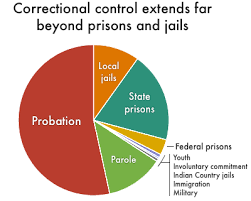
- No publications of court proceedings:
If charges are filed in court, the minor is arraigned, and charges are read before the judge. After hearing all charges, the judge decides either to detain or release the minor until the hearing takes place. After appearing in court, three things take place.
- Plea agreement:
In this minor, enter a plea agreement with the court. The Juvenile has to comply with certain conditions like attending counselling, obeying curfew, and paying restitution. - Diversion:
The Judge diverts the case and retains control over the matter until the juvenile comply the conditions. If a minor fails to comply, formal charges may be restored. - Adjuratory Hearing:
A trial of juvenile cases occurs. Both parties argue and provide evidence. Trial only happens in front of a judge, not a jury. At the end of the hearing, the judge decides on punishments like probation or detention in juvenile courts.
All these processes take place in front of the judge, and there are no publications of hearings. The main motto behind this is to save minors from social stigma.
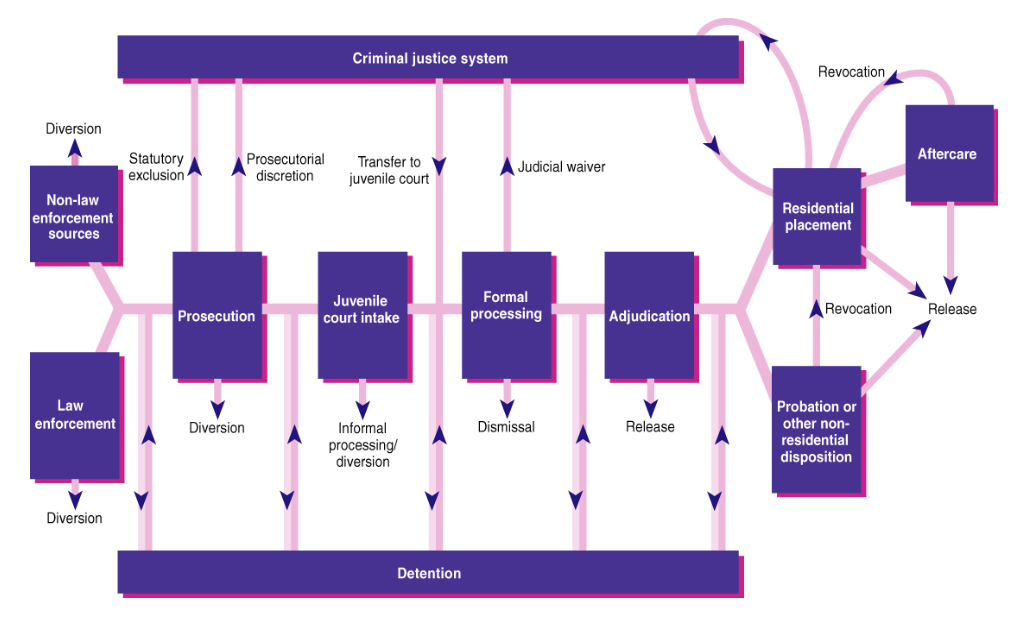
Conclusion:
To cut a long story short, after seeing a surge in juvenile involvement in crimes, the juvenile justice system came into action. The Juvenile justice system has a long-standing history, it evolves in a series. However, the constructive role of the juvenile justice system is the most crucial thing, which enables the justice system to fulfil its purpose of formation holistically.

CSS Solved Past Papers’ Essays
Looking for the last ten years of CSS and PMS Solved Essays and want to know how Sir Kazim’s students write and score the highest marks in the essays’ papers? Then, click on the CSS Solved Essays to start reading them.
CSS Solved Essays

CSS Solved General Science & Ability Past Papers
Want to read the last ten years’ General Science & Ability Solved Past Papers to learn how to attempt them and to score high? Let’s click on the link below to read them all freely. All past papers have been solved by Miss Iqra Ali & Dr Nishat Baloch, Pakistan’s top CSS GSA coach having the highest score of their students.
General Science & Ability Solved Past Papers
CSS Solved Pakistan Affairs Past Papers
Want to read CSS Pakistan Affairs Solved Past Papers and learn how to attempt them to score high? Let’s click on the link below to read them all freely. All past papers’ questions have been attempted by Sir Kazim’s students, who scored the highest in the subject.
CSS Solved Pakistan Affairs
CSS Solved International Relations’ Past Papers
Have you opted for International Relations in the CSS examination and want to score above 150? Then, click on the CSS Solved International Relations’ Past Papers by Miss Abeera Fatima, the top IR scorer and the best IR coach in Pakistan.
CSS Solved International Relations Past Papers
Articles Might Interest You!
The following are some of the most important articles for CSS and PMS aspirants. Click on any to start reading.

